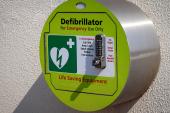Nonindicated Atrial Lead for Primary Prevention ICDs Linked to Complications
Guidelines urge single-chamber ICDs for primary prevention, but dual-chamber implants are still common and may pose harm.

Routine placement of atrial leads is common during implantable cardioverter-defibrillator (ICD) implantation for primary prevention despite guidelines that discourage it—now there are new observational data to support an increased risk of complications with dual-chamber implantation.
Writing in the Journal of the American Heart Association, Gilad Margolis, MD (Technion, Haifa, Israel), and colleagues note that landmark trials failed to establish a benefit of dual-chamber pacing in primary prevention ICD implantation, yet the practice has persisted. A 2014 expert consensus document on the use of ICDs in patients underrepresented in trials, as well as the recent European Society of Cardiology sudden cardiac death guidelines, urge single-chamber ICD placement so long as the patient has no other current or anticipated indications for pacing.
“People still feel that having atrial electrodes, atrial leads, will help differentiate between the ventricular tachycardias [VTs] and the supraventricular tachycardias [SVTs],” senior author Guy Rozen, MD, MHA (Tufts Medical Center, Boston, MA), told TCTMD. “Today we know that the way we program the devices—the algorithms the devices have to do the discrimination between VTs and SVTs—are very good, even for the single-chamber device. And actually, the inappropriate shocks the patients get for those SVTs or atrial fibrillation are very, very low, even with single chamber devices, but I think many cardiologists still feel that having the atrial lead can improve the discrimination between the dangerous VTs that need to be shocked and SVTs that don’t need to be shocked.”
Large, Real-world Data Set
For their study, Margolis et al turned to the National Inpatient Sample, identifying 15,940 patients who underwent ICD implantation in the United States between 2015 and 2019. More than half—55.6%—received a dual-chamber ICD without having any additional indications for pacing with an atrial lead.
In-hospital complication rates were higher for dual-chamber than for single-chamber ICD placements: 12.8% versus 10.7%, respectively (P < 0.001). Pneumothorax/hemothorax were the chief drivers of these higher complication rates, occurring in 4.6% and 3.4% (P < 0.001) of dual- and single-chamber patients, respectively. Lead dislodgements were also more common: 3.6% versus 2.3% (P < 0.001).
In multivariate analyses, dual-chamber configuration was an independent predictor for any complications, for pneumo/hemothorax, and for lead dislodgement.
According to the authors, the placement of nonindicated atrial leads in primary prevention ICDs has been on the decline over the last two decades, but the current study, as well as another published in JAMA Network Open last year, suggest that the practice is still common. Meanwhile, data continue to accumulate showing that the implantation of more than one lead can increase the risk of complications noted by Margolis et al, as well as lead-related venous obstruction, as reported recently in the Journal of the American College of Cardiology.
“This is not a new [phenomenon], this is something that was described in the past, but this is the first study that is a real-world, nationwide study showing how many ICDs today are dual chamber versus single chamber in patients that don't have a specific requirement for atrial leads,” Rozen said.
“The most important message is that the patients that need a primary prevention ICD and do not have a specific indication for the atrial lead implantation should all be getting single-chamber ICDs with just the ventricular lead,” he said. That’s explicitly stated in the European guidelines, he reiterated, and he expects the next iteration of the US guidelines—which tend to be updated less often—to reflect the same advice.
Slowly Shifting Practice
Fred Kusumoto, MD (Mayo Clinic, Jacksonville, FL), led the 2014 US consensus document, wrote an editorial accompanying the recent JACC analysis on lead-related venous obstruction, and commented on the Margolis et al paper for TCTMD.
“There is mixed data for the utility of an atrial lead to help discriminate among different arrhythmias, but personally I think the additional benefit low,” Kusumoto said in an email. In the current study, he continued, “although the absolute difference in complication rates is low, I believe the additional risk of adding an atrial lead is clinically significant and for this reason in my personal practice I rarely implant dual-chamber ICDs.”
Whether any updated US guidelines will include recommendations against dual-chamber ICDs for primary prevention will depend on the guideline chair(s) and the chair of the American Heart Association/American College of Cardiology guidelines task force, Kusumoto added—if not, they may leave this to subspecialty organizations, like the Heart Rhythm Society.
Asked if reimbursement might play a role in driving physician decisions to add atrial pacing, Kusumoto noted that there is a separate CPT code for atrial lead implantation. “But whether there is additional reimbursement (whether to the physician or the facility) varies dramatically,” he said. “Interestingly, in an analysis from 2022 of the NCDR, . . . it appeared that dual-chamber ICDs were more likely to be implanted in private institutions compared to university settings, but they did identify a trend towards decreased use of dual-chamber ICDs over the study period.”
Shelley Wood is the Editor-in-Chief of TCTMD and the Editorial Director at CRF. She did her undergraduate degree at McGill…
Read Full BioSources
Margolis G, Hamuda N, Kobo O, et al. Single‐versus dual‐chamber implantable cardioverter‐defibrillator for primary prevention of sudden cardiac death in the United States. J Am Heart Assoc. 2023;12:e029126.
Disclosures
- Both Rozen and Kusumoto report having no relevant conflicts of interest.




Comments